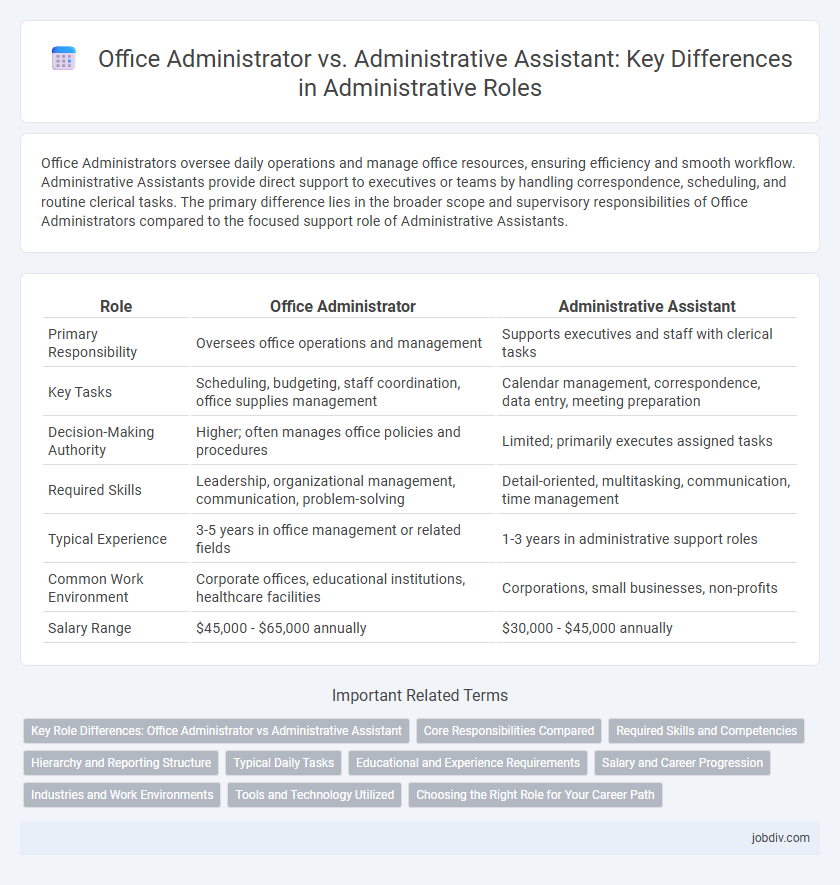Office Administrators oversee daily operations and manage office resources, ensuring efficiency and smooth workflow. Administrative Assistants provide direct support to executives or teams by handling correspondence, scheduling, and routine clerical tasks. The primary difference lies in the broader scope and supervisory responsibilities of Office Administrators compared to the focused support role of Administrative Assistants.
Table of Comparison
| Role | Office Administrator | Administrative Assistant |
|---|---|---|
| Primary Responsibility | Oversees office operations and management | Supports executives and staff with clerical tasks |
| Key Tasks | Scheduling, budgeting, staff coordination, office supplies management | Calendar management, correspondence, data entry, meeting preparation |
| Decision-Making Authority | Higher; often manages office policies and procedures | Limited; primarily executes assigned tasks |
| Required Skills | Leadership, organizational management, communication, problem-solving | Detail-oriented, multitasking, communication, time management |
| Typical Experience | 3-5 years in office management or related fields | 1-3 years in administrative support roles |
| Common Work Environment | Corporate offices, educational institutions, healthcare facilities | Corporations, small businesses, non-profits |
| Salary Range | $45,000 - $65,000 annually | $30,000 - $45,000 annually |
Key Role Differences: Office Administrator vs Administrative Assistant
Office Administrators oversee overall office functions including facility management, budget tracking, and coordinating interdepartmental communication, ensuring smooth operational workflow. Administrative Assistants primarily provide direct support to executives or teams by managing schedules, handling correspondence, and preparing documents. The key role difference lies in Office Administrators focusing on office-wide organization and resource management, whereas Administrative Assistants concentrate on individual or departmental administrative support.
Core Responsibilities Compared
Office Administrators oversee overall office operations, managing facilities, coordinating schedules, and supervising administrative staff to ensure efficient workflow. Administrative Assistants focus on supporting executives or teams through tasks such as managing correspondence, organizing meetings, and maintaining records. Both roles require strong organizational skills but differ in scope, with Office Administrators holding broader managerial responsibilities and Administrative Assistants providing direct clerical support.
Required Skills and Competencies
Office Administrators require advanced organizational skills, proficiency in office management software, and strong leadership abilities to oversee daily operations and coordinate team activities. Administrative Assistants need excellent communication skills, attention to detail, and multitasking capabilities to manage schedules, handle correspondence, and support executives efficiently. Both roles demand problem-solving aptitude, time management, and adaptability to maintain smooth administrative functions.
Hierarchy and Reporting Structure
An Office Administrator typically holds a higher position within the organizational hierarchy, overseeing office operations and managing administrative staff, including Administrative Assistants. Administrative Assistants report directly to Office Administrators or department managers, providing clerical support, scheduling, and communication assistance. The Office Administrator ensures workflow efficiency and handles more complex administrative responsibilities, while Administrative Assistants focus on task-specific duties under supervision.
Typical Daily Tasks
Office Administrators typically manage scheduling, coordinate office operations, and oversee inventory control to ensure smooth workflow. Administrative Assistants focus on supporting executives with calendar management, preparing documents, and handling correspondence to facilitate efficient communication. Both roles require proficiency in office software and multitasking to maintain organizational effectiveness.
Educational and Experience Requirements
Office Administrators typically require a bachelor's degree in business administration or a related field combined with 3-5 years of experience in office management or administrative roles. Administrative Assistants often need a high school diploma or associate degree with 1-3 years of experience supporting executives or office teams. Both roles benefit from proficiency in office software, organizational skills, and strong communication abilities, but Office Administrators usually hold more advanced educational credentials and greater experience.
Salary and Career Progression
Office Administrators typically earn higher salaries than Administrative Assistants due to broader responsibilities including managing office operations and coordinating team activities. Career progression for Office Administrators often leads to senior management roles or specialized administrative positions, whereas Administrative Assistants usually advance into executive assistant roles or more focused administrative specialties. Salary ranges for Office Administrators generally fall between $45,000 and $65,000 annually, while Administrative Assistants earn approximately $35,000 to $50,000 depending on experience and industry.
Industries and Work Environments
Office Administrators typically work in corporate settings, healthcare facilities, educational institutions, and government agencies, overseeing office operations and coordinating between departments. Administrative Assistants often support specific executives or teams in industries like finance, legal, marketing, and technology, handling scheduling, correspondence, and routine clerical tasks. The work environment for Office Administrators tends to be broader and more managerial, while Administrative Assistants operate in focused, sometimes fast-paced office settings.
Tools and Technology Utilized
Office Administrators primarily utilize comprehensive office management software such as Microsoft Office Suite, Google Workspace, and enterprise resource planning (ERP) systems to coordinate operations and streamline workflow. Administrative Assistants often rely on scheduling tools like Microsoft Outlook, communication platforms including Slack or Zoom, and basic data entry software to support executives and manage daily tasks. Both roles demand proficiency in digital calendars, document management systems, and collaboration tools to enhance organizational efficiency.
Choosing the Right Role for Your Career Path
Office Administrators oversee daily operations, manage office resources, and coordinate team activities, making them ideal for those seeking leadership roles in administrative management. Administrative Assistants provide essential support through scheduling, communication management, and clerical tasks, suited for individuals aiming to develop specialized skills in organizational support. Evaluating your strengths and career goals helps determine whether a managerial focus as an Office Administrator or a supportive role as an Administrative Assistant aligns best with your professional growth.
Office Administrator vs Administrative Assistant Infographic

 jobdiv.com
jobdiv.com